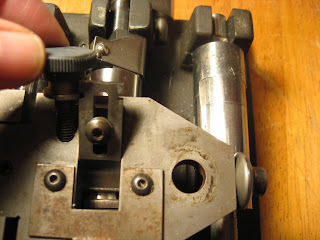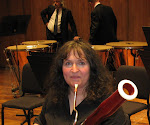Symphony orchestras these days must explore new ways to attract audiences and stir public support. Here in Columbus we've performed shows such as "Barbie," "Video Games Live." and "Lord of the Rings." This week, our venture into the realm of the experimental continues with the original 1939 classic film "The Wizard of Oz." The instrumental music has been removed from the sound track, and the Columbus Symphony will perform it live tonight while the movie is projected onto a large screen onstage above the orchestra. Here's a brief description of the Symphonic Night at the Movies event from the Columbus Dispatch. I am amazed at conductor Constantine Kitsopoulos' ability to keep the orchestra coordinated with the film. Read Columbus Symphony horn player Julia Rose's description of what it was like to play along with a movie.
I am equally amazed by the level of difficulty of the film score. I have a newfound appreciation for the work of bassoonists such as Norman Herzberg and Don Christlieb who were famous for their movie studio recording in Los Angeles during past decades. I have heard stories of the studio musicians being expected to sight-read the rehearsal (the one and only rehearsal!) just before recording began! To add to the excitement, apparently the music was often re-written on the spot! Clearly, those studio musicians were superb sight readers with outstandingly reliable technique. Norman Herzberg was famous for teaching his bassoon students how to develop that sort of technique.
Unlike the L.A. studio musicians who originally performed this music, I had the luxury of being able to obtain my Wizard of Oz part in advance of the two rehearsals. Still, I ended up being surprised by the number of very exposed bassoon licks, many of which are very tricky. On top of that, we have to be extremely nimble, following the conductor who is at the mercy of the twists and turns of the yellow brick road.
My part was full of challenges; I'll point out a few here. One of the most challenging passages I've played in a long time accompanied Toto bringing good news (albeit bad news for the bassoonist):
It doesn't look terribly daunting at first glance, does it? Hah. It's in two, and the tempo is fast- so fast that I'm using the short F#3 fingering, which I rarely resort to:
Although the passage is tongued, the tonguing is not the problem- the fingerings are the problem. Most of my early practice time on this was done without the tongue, slurring everything. I'm hoping that will pay off during tonight's performance.
In the above passage, you can see that I wrote in the 2 subsequent notes at the end of measure 32. I often do that when a challenging passage is continued on the next line and the notes on the next line are not intuitive or not part of an obvious pattern.
Here's an example of one of the unusual solos which require the bassoonist to be on high alert for the conductor's sudden launch out of a fermata. As you can see, I decided to employ my oft-used technique of writing the passage at the top of the page to increase my chances of being with the conductor (this passage actually appears in the worst possible location: the bottom of the page):
During yesterday morning's rehearsal I found myself accidentally repeating a line, which sometimes occurs when 2 or more lines look similar on the page. Whenever that happens, I automatically employ the technique taught to me by Ryohei Nakagawa: I draw a geometric shape at the end of one line and repeat it at the beginning of the next line. Then I use a different shape for the end of that line, corresponding to the same shape at the beginning of the next line. It never fails to solve the problem:
Although the 1st bassoonist is sure to be wiped out by the time the end of the movie is on the horizon, this totally exposed solo appears on page 49 of the bassoon part:
There is a ritard printed, but it doesn't happen! The bassoonist has to barrel down to low Bflat on a reed which just moments earlier had to pop out solos in the bassoon's stratosphere. I think the title of this number has a typo; it should be called "Bassoon Ascension" or maybe "Bassoon Descension."
P.S.(next day) Last night's Symphonic Night at the Movies was a huge success, with a packed hall and a very appreciative audience. Read the rave review from the Columbus Dispatch.
Sunday Morning Music
-
John Taverner: O splendor gloriae The Sixteen: Harry Christophers,
COnductor O splendor of glory and image of substance God the Father
almighty, Jesus Chri...
2 days ago









































